- Table of Content
- 1.NOAA 3599's sp...
- 2.PiTHIA-NRF 3rd...
- 3.Review of sola...
- 4.International ...
- 5.PROBA2 Observa...
- 6.Noticeable Sol...
- 7.Geomagnetic Ob...
- 8.Review of Iono...
- 9.The SIDC Space...
- 10.STCE Activitie...
2. PiTHIA-NRF 3rd Innovation Day
3. Review of solar and geomagnetic activity
4. International Sunspot Number by SILSO
5. PROBA2 Observations
6. Noticeable Solar Events
7. Geomagnetic Observations in Belgium
8. Review of Ionospheric Activity
9. The SIDC Space Weather Briefing
10. STCE Activities
NOAA 3599's spectacular eruption
Active region NOAA 3599 had already rounded the Sun's southwest limb when it produced a long duration C-class flaring event. This event consisted of 3 individual flares which seemed to be part of one big ongoing magnetic restructuring near this active region. The event started at 00:59UTC and ended at 06:59 UTC, with a C1.9 flare peaking at 01:45UTC, a C4.9 at 04:05UTC, and a C6.0 flare peaking at 06:10UTC. The graph underneath shows the evolution in soft x-rays as recorded by GOES (https://www.swpc.noaa.gov/products/goes-x-ray-flux ).
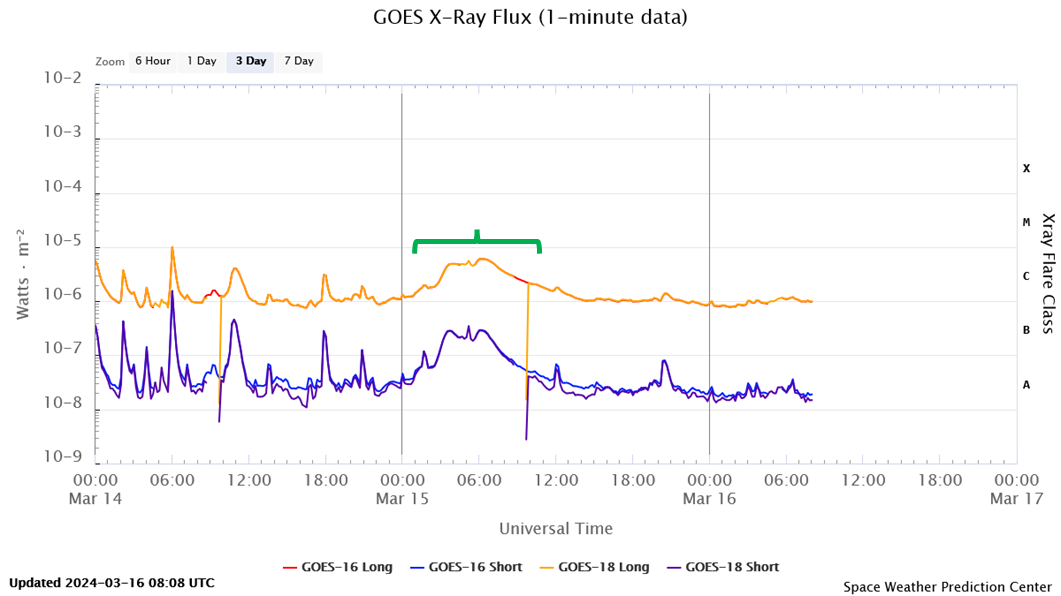
Extreme ultraviolet (EUV) images taken by the GOES/SUVI (https://www.swpc.noaa.gov/products/goes-solar-ultraviolet-imager-suvi ) instrument showed the complexity of the eruption as it unfolded. The imagery underneath combines SUVI 171 (temperatures around 700.000 degrees) with SUVI 094 (multi-million degrees) filters, in respectively yellow-green and purple-pink colours. SUVI 171 gives a good view on the ejected magnetic structures, the magnetic restructuring and the series of post-eruption coronal loops ("arcade"). SUVI 094 gives a good view on the SADs, i.e. the supra-arcade downflows. More information on SADs can be found in the STCE newsitems here https://www.stce.be/news/630/welcome.html and here https://www.stce.be/news/562/welcome.html A clip is available in the online version at https://www.stce.be/news/691/welcome.html Note the off-disk corona has been enhanced (SWHV - http://swhv.oma.be/user_manual/ ), and the brief interruption in the clip is due to GOES "eclipse-season", i.e. the Earth passing briefly in between the Sun and GOES thus blocking GOES/SUVI's view of the Sun.
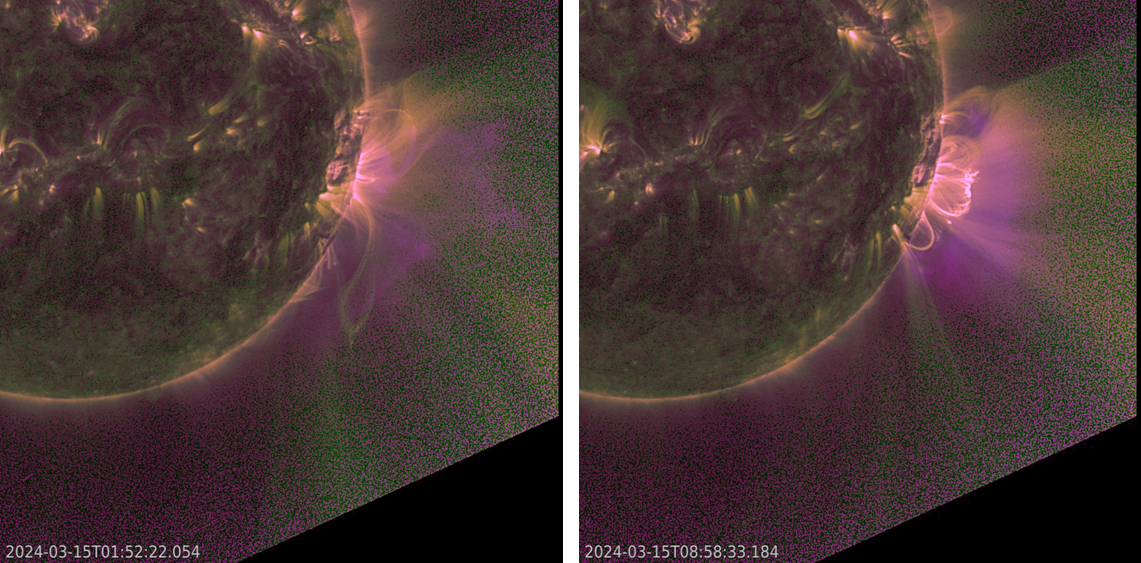
The EUV images clearly indicate material was ejected into space, and sure enough the coronagraphs on board SOHO (http://sohowww.nascom.nasa.gov/data/realtime-images.html ) showed an impressive partial halo coronal mass ejection (CME). It was mostly directed towards the west, and was -correctly- thought not to be directed towards the Earth in view of the position of the source region (behind the solar limb). Its plane-of-the-sky speed was around 750 km/s (CACTus - https://www.sidc.be/cactus/ ). Nonetheless, a minor proton event was observed peaking on 16 March at 16 pfu (proton flux units - https://www.stce.be/educational/acronym#P ). In the imagery underneath, the SOHO/LASCO coronagraphic images are overlaid on the SUVI 094 EUV image. The CME at the end of the clip moving southward is thought to have a farside source.
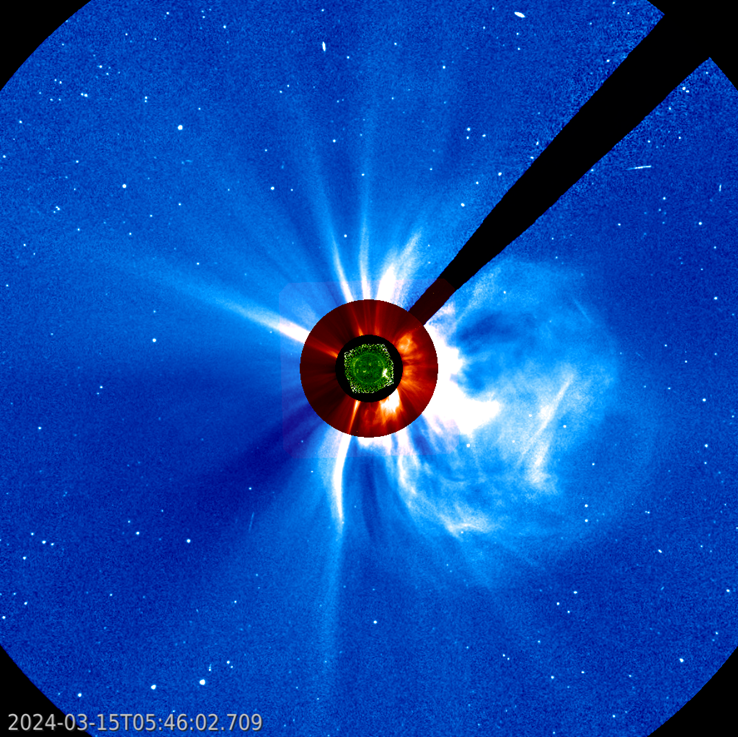
PiTHIA-NRF 3rd Innovation Day

Plasmasphere Ionosphere Thermosphere Integrated Research Environment and Access services is a European Network of Research Facilities (PITHIA-NRF) that integrates observing facilities, data processing tools and prediction models dedicated to ionosphere, thermosphere and plasmasphere research.
Registration for the PITHIA-NRF 3rd Innovation Day is now open!
https://pithia-nrf.eu/pithia-nrf-users/innovation/innovation-day-3
The Third Innovation Day, organised by the PITHIA-NRF consortium, will be held on 12 June 2024 in Warsaw, Poland. It is the last in a series of PITHIA-NRF project events focused on user needs, aiming to bring together representatives from various industries, including but not limited to SMEs, the aerospace sector, and civil organisations, with experts in upper atmospheric research to exchange ideas, share knowledge, and explore new avenues of collaboration.
Join us at the 3rd Innovation Day for an opportunity to learn about the achievements of the PITHIA-NRF project, meet its stakeholders, and hear their success stories. You'll also have the chance to learn more about the e-Science Centre and the research infrastructure of PITHIA.
Additionally, you can engage with our experts in one-on-one B2B meetings. Remember, PITHIA-NRF prioritises its users, valuing your ideas and input. Whether you have ideas to share or challenges to discuss, our expert team members are here to provide feedback. If you're interested in registering your data with the PITHIA-NRF e-Science Centre, we can guide you through the process. Don't hesitate – contact us and be part of the Third Innovation Day!
Looking forward to seeing you in Warsaw!
The PITHIA-NRF Consortium
Review of solar and geomagnetic activity
WEEK 1211 from 2024 Mar 11
Solar Active Regions and flares
There were 15 active regions (ARs) visible throughout the week. Only NOAA AR 3599 evolved into a complex magnetic field configuration (beta-gamma-delta) and created most of the flaring during the week. The other active regions had simple magnetic field configurations (alpha or beta). By the end of the week, with NOAA AR 3599 out of view, the flaring activity shifted to NOAA AR 3612 and to two active regions rotating into view from the east limb (one unnumbered and NOAA AR 3614).
Coronal mass ejections
An M7.4 flare from NOAA AR 3599 on March 10 was related to dimmings and an EUV wave and CME directed towards the west. The CME was not very wide (apparent angular width of about 70 degrees) and had a speed close to 500 km/s.
On 13 March, a partial halo CME with angular width around 150 degrees was first seen by LASCO C2 at 08:57 UT. There were no signatures of an eruption on the visible solar disk, so this CME was deemed backsided.
On 14 March we observed a partial halo CME, seen by LASCO C2 at 05:08 UTC, with an angular width of about 140 degrees, directed towards the east. This eruption occurred close to the limb but was mostly backsided.
On 15 March, one more partial halo CME was observed by LASCO C2 at 02:10 with an angular width of 150 degrees and directed towards the west (related to flaring activity from NOAA AR 3599 over the west limb). This eruption also occurred close to the limb and was mostly backsided.
On 17 March, a partial halo CME (angular width about 180 degrees) was observed, directed towards the south, first seen at 03:24 UTC by LASCO C2. This CME originated from a filament eruption in the southern hemisphere.
Coronal Holes
An equatorial (positive polarity) coronal hole crossed the central meridian on March 10.
Proton flux levels
The partial halo CME on March 15 was associated with an increase in the 10 MeV proton flux at Earth; it crossed the 10 pfu threshold and remained elevated during 16 March. It is still slowly returning to background levels at the moment of writing (but below the threshold). The rest of the week the proton flux was at background levels.
Electron fluxes at GEO
The greater than 2 MeV electron flux was below the threshold level, except on 10-11 March when it was slightly above. The electron fluence was at normal levels throughout the week.
Solar wind
The solar wind was slow the entire week, with speeds below 500 km/s and interplanetary magnetic field below 10 nT.
Geomagnetism
The geomagnetic conditions were quiet to unsettled the whole week, both locally and globally, except for a brief interval on 15 March where they reached active levels.
International Sunspot Number by SILSO
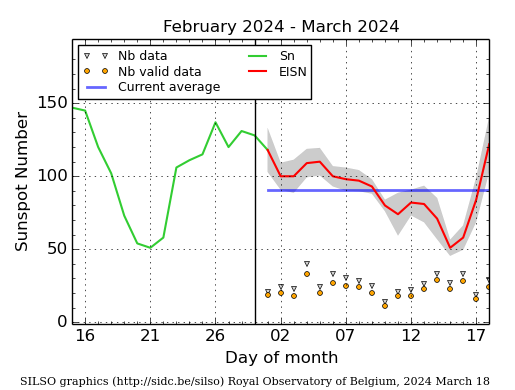
The daily Estimated International Sunspot Number (EISN, red curve with shaded error) derived by a simplified method from real-time data from the worldwide SILSO network. It extends the official Sunspot Number from the full processing of the preceding month (green line), a few days more than one solar rotation. The horizontal blue line shows the current monthly average. The yellow dots give the number of stations that provided valid data. Valid data are used to calculate the EISN. The triangle gives the number of stations providing data. When a triangle and a yellow dot coincide, it means that all the data is used to calculate the EISN of that day.
PROBA2 Observations
Solar Activity
Solar flare activity fluctuated from low to moderate during the week.
In order to view the activity of this week in more detail, we suggest to go to the following website from which all the daily (normal and difference) movies can be accessed: https://proba2.oma.be/ssa
This page also lists the recorded flaring events.
A weekly overview movie can be found here (SWAP week 729). https://proba2.sidc.be/swap/data/mpg/movies/weekly_movies/weekly_movie_2024_03_11.mp4
Details about some of this week's events can be found further below.
If any of the linked movies are unavailable they can be found in the P2SC movie repository here https://proba2.sidc.be/swap/data/mpg/movies/
Saturday Mar 16
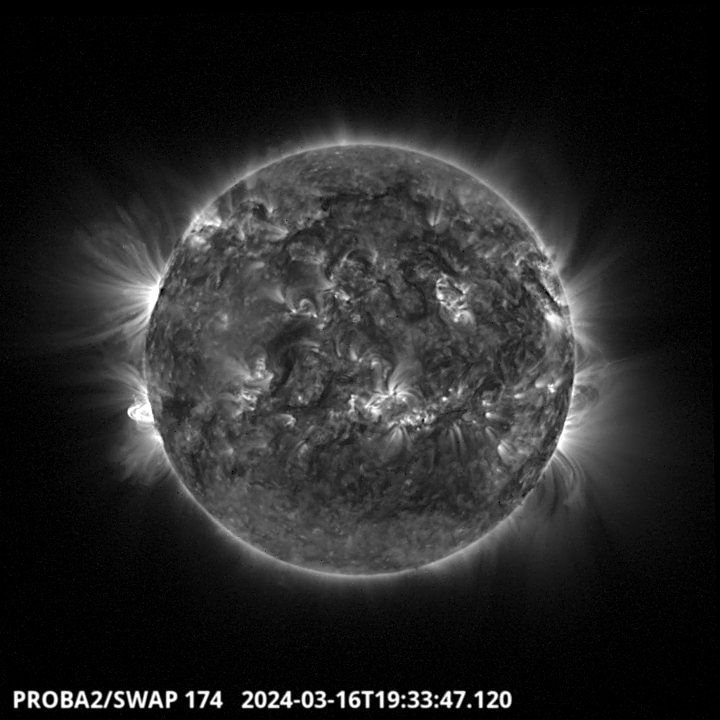
The largest flare of the week, a M3.5, was produced around 16:35 UT on March 16. The source
was just behind the sun's southeastern limb. Find a SWAP movie of the event here. https://proba2.sidc.be/swap/data/mpg/movies/20240316_swap_movie.mp4
Sunday Mars 17
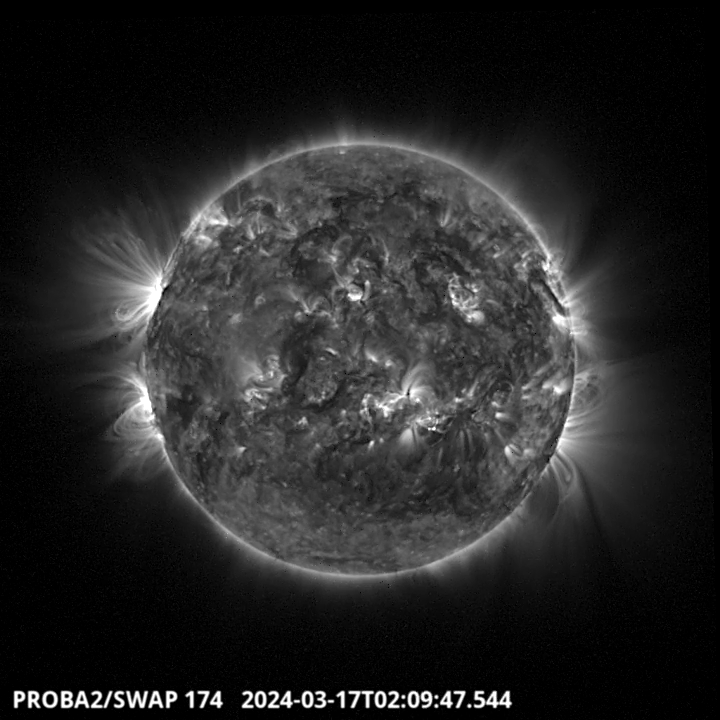
A large filament across the southern hemisphere erupted on March 17 around 2:10 UT.
Find a SWAP movie of the event here. https://proba2.sidc.be/swap/data/mpg/movies/20240317_swap_movie.mp4
Noticeable Solar Events
| DAY | BEGIN | MAX | END | LOC | XRAY | OP | 10CM | TYPE | Cat | NOAA |
| 14 | 0552 | 0604 | 0611 | S11W82 | M1.0 | SF | III/1VI/1 | 99 | 3599 | |
| 16 | 1622 | 1635 | 1644 | M3.5 | ||||||
| 16 | 2127 | 2155 | 2211 | M1.1 |
| LOC: approximate heliographic location | TYPE: radio burst type |
| XRAY: X-ray flare class | Cat: Catania sunspot group number |
| OP: optical flare class | NOAA: NOAA active region number |
| 10CM: peak 10 cm radio flux |
Geomagnetic Observations in Belgium
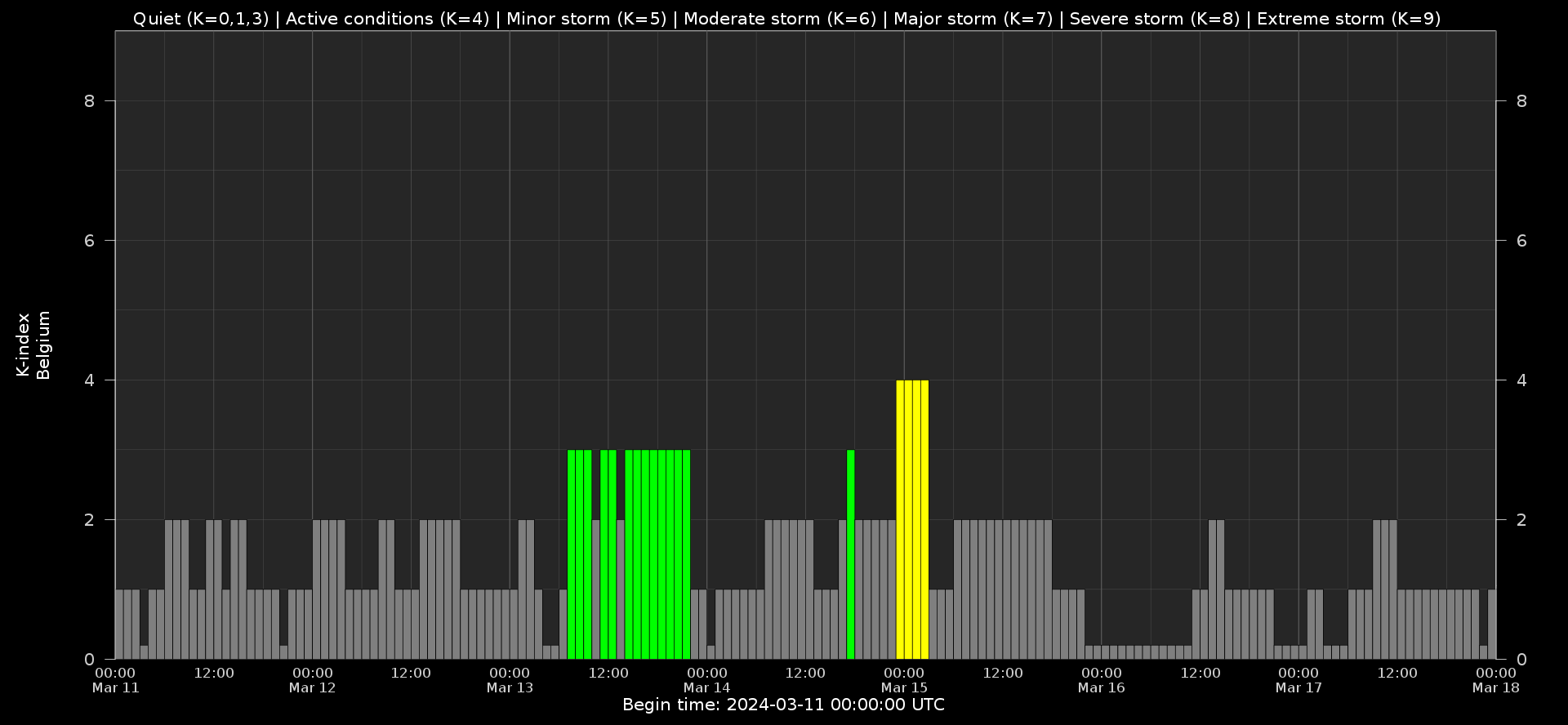
Local K-type magnetic activity index for Belgium based on data from Dourbes (DOU) and Manhay (MAB). Comparing the data from both measurement stations allows to reliably remove outliers from the magnetic data. At the same time the operational service availability is improved: whenever data from one observatory is not available, the single-station index obtained from the other can be used as a fallback system.
Both the two-station index and the single station indices are available here: http://ionosphere.meteo.be/geomagnetism/K_BEL/
Review of Ionospheric Activity
NEW! The time series below illustrates (in green) the VTEC deviation from normal quiet behaviour.
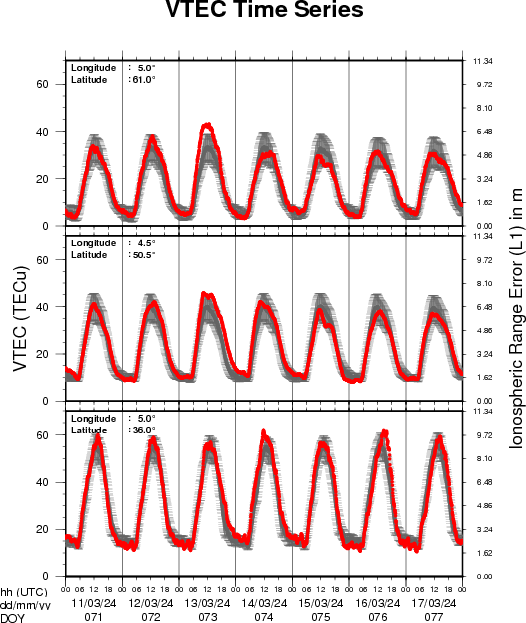
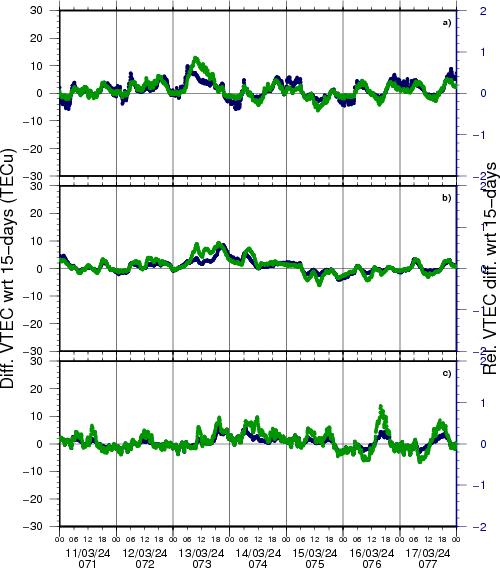
VTEC time series at 3 locations in Europe from 11 Mar 2024 till 17 Mar 2024
The top figure shows the time evolution of the Vertical Total Electron Content (VTEC) (in red) during the last week at three locations:
a) in the northern part of Europe(N 61deg E 5deg)
b) above Brussels(N 50.5deg, E 4.5 deg)
c) in the southern part of Europe(N 36 deg, E 5deg)
This top figure also shows (in grey) the normal ionospheric behaviour expected based on the median VTEC from the 15 previous days.
The time series below shows the VTEC difference (in green) and relative difference (in blue) with respect to the median of the last 15 days in the North, Mid (above Brussels) and South of Europe. It thus illustrates the VTEC deviation from normal quiet behaviour.
The VTEC is expressed in TECu (with TECu=10^16 electrons per square meter) and is directly related to the signal propagation delay due to the ionosphere (in figure: delay on GPS L1 frequency).
The Sun's radiation ionizes the Earth's upper atmosphere, the ionosphere, located from about 60km to 1000km above the Earth's surface.The ionization process in the ionosphere produces ions and free electrons. These electrons perturb the propagation of the GNSS (Global Navigation Satellite System) signals by inducing a so-called ionospheric delay.
See http://stce.be/newsletter/GNSS_final.pdf for some more explanations; for more information, see https://gnss.be/SpaceWeather
The SIDC Space Weather Briefing
The forecaster on duty presented the SIDC briefing that gives an overview of space weather from March 11 to 17.
The pdf of the presentation can be found here: https://www.stce.be/briefings/20240318_SWbriefing.pdf

STCE Activities
Courses and presentations with the Sun-Space-Earth system and Space Weather as the main theme. We provide occasions to get submerged in our world through educational, informative and instructive activities.
* March 26, Solar physics and Space Weather: Sunspots and Solar Radio Astronomy, online course - Registrations are open
* March 28-29, 2024, STCE Space Weather Introductory Course, focus on aviation, online - Registrations are open
* April 22-24, 2024, STCE Space Weather Introductory Course, Brussels, Belgium - Registrations are open
* April 26, Public presentation Proba-3: a solar eclipse maker, MIRA, Grimbergen
* April 30, Solar physics and Space Weather: Proba-2 and Proba-3, online course - Registrations are open
* May 3, STCE seminar, An Echo of the Sun, Brussels, Belgium
* May 6, An Echo of the Sun, PhD defense Pepa Ivanova, Brussels, Belgium
* May 13, lecture by the STCE, From physics to forecasting, ESA Space Weather Training Course 2024, Euro Space Center, Redu, Belgium
* may 14, STCE Seminar, Segmentation, grouping and classification of sunspots from ground-based observations using deep learning methods, Brussels, Belgium
* May 13 - 17, lectures by the STCE, solar and heliospheric weather; magnetosphere, ionosphere, aviation, and ground based impact, Course Operational Space Weather Fundamentals, L'Aquila, Italy
* May 18, Public presentation, The PROBA-3 Mission: Artificial Total Solar Eclipse in Space, FotonFest, Urania, Hove, Belgium
* May 28, Solar physics and Space Weather: Solar Orbiter Spacecraft, online course - Registrations are open
* June 9, Public presentation Total Eclipse of the Sun, Helios, Averbode, Belgium
* June 25, Solar physics and Space Weather: predictions and services, online course - Registrations are open
To register for a course or lecture, check the page of the STCE Space Weather Education Center: https://www.stce.be/SWEC
If you want your event in the STCE newsletter, contact us: stce_coordination at stce.be
